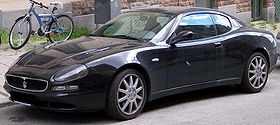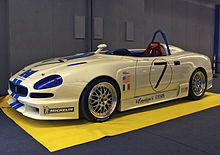Maserati 3200 GT
The Maserati 3200 GT (Tipo 338) is a four-seater grand tourer produced by Maserati from 1998 to 2002. The luxury coupé was styled by Italdesign, whose founder and head Giorgetto Giugiaro previously designed, among others, the Ghibli, Bora and Merak. Interiors design was commissioned to Enrico Fumia and completed by 1995. 4,795 cars were produced.
History
Introduction
The 3200 GT was announced in July 1998, presented to the press in September by Luca Cordero di Montezemolo, with the participation of veteran Maserati racing driver Sir Stirling Moss and Giorgetto Giugiaro, and finally made its public debut at the October 1998 Mondial de l'Automobile in Paris.
Its name honoured the Maserati 3500 GT, the Trident's first series production grand tourer. Sold mainly in Europe, the 3200 GT was powered by the twin-turbo, 32-valve, dual overhead cam 3.2-litre V8 engine featured in the Quattroporte Evoluzione, set up to develop 370 PS (272 kW; 365 hp) against the Quattroporte's 335 PS and achieved 116 PS (85 kW; 114 hp) per litre. This manual transmission version was produced until 2001. The tail-lights consisted of LEDs arranged in the shape of boomerang. The outer layer of the 'boomerang' provided the brake light, with the inner layer providing the directional indicator. This was the world's first car with LED taillights. Deliveries started in March 1999.In total 2,689 GT cars were produced.
3200 GT Automatica
In 1999 an automatic version of the 3200 GT became available, either referred to as 3200 GT Automatica or 3200 GTA. Introduced at the March 1999 Geneva Motor Show, it was equipped with a 4-speed conventional torque converter automatic transmission supplied by Australian firm BTR. Engine output remained unchanged, though the engine was set up specifically for the automatic; according to Maserati, the weight increase over the manual gearbox was limited to 30 kg (66.1 lb), for a 1,620 kg (3,571.5 lb) kerb weight. In Italy the Automatica commanded a 7 million Lire premium over the 3200 GT's 149.5 million Lire list price.This version was produced until 2002. In June 1999 the 1,000th 3200 GT left the factory.In total 2,106 GTA cars were produced.
3200 GT Assetto Corsa
Presented to the public at the 2001 Geneva Motor Show, the 3200 GT Assetto Corsa was a limited edition, run-out version of the 3200 with a special handling package. Limited to 259 units, 3 of which were special orders, it was available in three standard colours: Grigio Touring, Nero Carbonio and Rosso Mondiale; and available with manual or automatic transmission. The Assetto Corsa was lowered by 15 mm, had larger front anti-roll bar, stiffer springs, soft compound Pirelli PZero Corsa tyres on dark grey or silver painted BBS alloy wheels, and specific brake ventilation ducts.The interior featured black perforated Connolly leather seats with red stitching and 'Assetto Corsa' script on the sill kick panels. Both kerb weight and performance were unchanged from their regular counterparts. Production was divided between 163 manual and 96 automatic cars.
The car was replaced in early 2002 by the similarly styled, but mechanically wholly new Maserati Coupé, when Maserati returned to the US market.
Specifications
The 3200 GT coupé body seated four and had a drag coefficient of Cd=0.34.[The steel unibody structure was complemented by a front tubular subframe supporting the drivetrain and a rear subframe supporting the suspension links and the differential. Suspension was of the double wishbone type all around, with forged aluminium control arms and uprights, coaxial aluminium-bodied dampers and coil springs, and two anti-roll bars. The gearbox was in line with the front-mounted engine, and transmitted power to the rear limited slip differential via a two-piece aluminium driveshaft. Brembo supplied the braking system, consisting of vented and cross-drilled disks with four-pot callipers on all four wheels. Active safety systems included four channel anti-lock braking system and Bosch ASR traction control system.
Engines and performance
The all-aluminium V8 engine was square (bore and stroke 80 mm or 3.1 in), had two overhead camshafts per bank operating four valves per cylinder, two crossflow turbochargers, and a crossplane crankshaft; it featured "drive by wire" electronic throttle control. Engine itself weight is 221 kg (487 lb).
| Model | Years | Displacement | Peak power | Peak torque | Top speed | Accel. 0–100 km/h |
|---|---|---|---|---|---|---|
| 3200 GT[10] | 1998–2001 | 3,217 cc (196.3 cu in) | 370 PS (272 kW; 365 hp)* at 6250 rpm | 491 N⋅m (362 lb⋅ft) at 4500 rpm | 280 km/h (174 mph) | 5.12 s |
| 3200 GTA[5] | 1999–2002 | 270 km/h (168 mph) | 5.7 s |
*some sources state 271 kW (368 PS)
Maserati 320S
The Maserati 320S is a concept racing barchetta designed by Italdesign Giugiaro and based on the 3200 GT. It was first shown at the 2001 Geneva Motor Show. A true barchetta, the 320S was a single-seater fully outfitted for competition with six-point belts, an exposed roll bar behind the driver, fire extinguishing system and racing seat supplied by Sparco; weather protection was limited to a small aeroscreen in front of the driver. Compared to the 3200 GT, the 320S's wheelbase was shortened by 22 cm (8.7 in), while the engine remained the 370 PS twin-turbo V8 with 6-speed gearbox. 320s
Bodywork of the 320S features modifications to the aerodynamic shaping of the spoiler on the rear bumper, which features a supplementary nolder to increase the vertical load to the rear.








![Validate my RSS feed [Valid RSS]](valid-rss-rogers.png)

































































ไม่มีความคิดเห็น:
แสดงความคิดเห็น